International Trade Law Assignment: Tutorials and Case Study
VerifiedAdded on 2021/08/20
|28
|10143
|172
Homework Assignment
AI Summary
This document presents a comprehensive solution to an International Trade Law assignment. It begins with a table of contents and then provides answers to various tutorial questions, including true/false questions with explanations, short answer questions covering sources of international trade law, and comparisons of trade agreements like EVFTA and CPTPP. The assignment also includes a detailed case study involving a sale of goods between Vietnamese and Japanese companies, analyzing the application of CISG 1980 and the validity of acceptance and contract formation. Furthermore, the solution covers the World Trade Organization (WTO), its functions, and decision-making processes. The document offers a thorough analysis of key concepts and legal principles within the realm of international trade law.
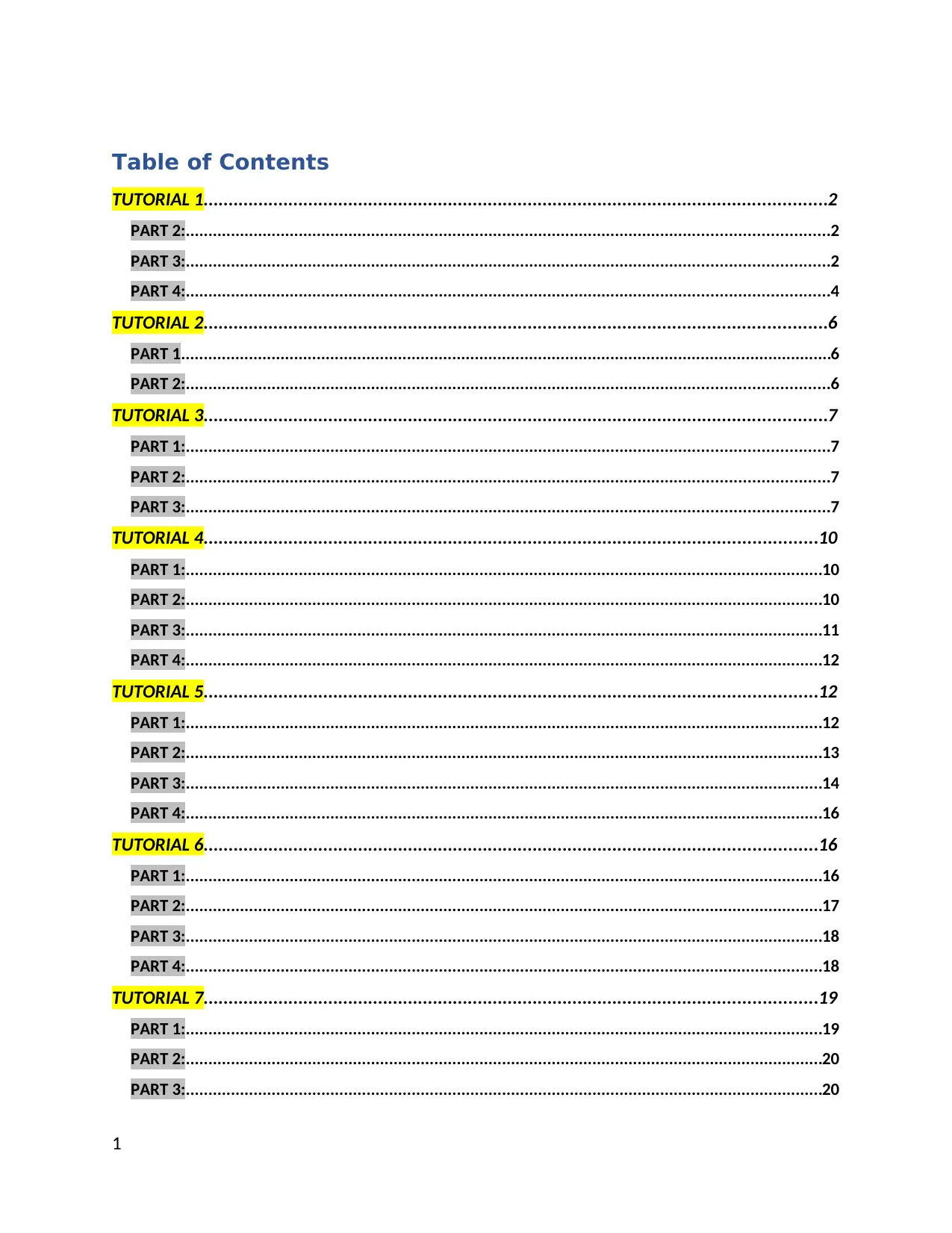
Table of Contents
TUTORIAL 1.............................................................................................................................2
PART 2:..............................................................................................................................................2
PART 3:..............................................................................................................................................2
PART 4:..............................................................................................................................................4
TUTORIAL 2.............................................................................................................................6
PART 1................................................................................................................................................6
PART 2:..............................................................................................................................................6
TUTORIAL 3.............................................................................................................................7
PART 1:..............................................................................................................................................7
PART 2:..............................................................................................................................................7
PART 3:..............................................................................................................................................7
TUTORIAL 4...........................................................................................................................10
PART 1:.............................................................................................................................................10
PART 2:.............................................................................................................................................10
PART 3:.............................................................................................................................................11
PART 4:.............................................................................................................................................12
TUTORIAL 5...........................................................................................................................12
PART 1:.............................................................................................................................................12
PART 2:.............................................................................................................................................13
PART 3:.............................................................................................................................................14
PART 4:.............................................................................................................................................16
TUTORIAL 6...........................................................................................................................16
PART 1:.............................................................................................................................................16
PART 2:.............................................................................................................................................17
PART 3:.............................................................................................................................................18
PART 4:.............................................................................................................................................18
TUTORIAL 7...........................................................................................................................19
PART 1:.............................................................................................................................................19
PART 2:.............................................................................................................................................20
PART 3:.............................................................................................................................................20
1
TUTORIAL 1.............................................................................................................................2
PART 2:..............................................................................................................................................2
PART 3:..............................................................................................................................................2
PART 4:..............................................................................................................................................4
TUTORIAL 2.............................................................................................................................6
PART 1................................................................................................................................................6
PART 2:..............................................................................................................................................6
TUTORIAL 3.............................................................................................................................7
PART 1:..............................................................................................................................................7
PART 2:..............................................................................................................................................7
PART 3:..............................................................................................................................................7
TUTORIAL 4...........................................................................................................................10
PART 1:.............................................................................................................................................10
PART 2:.............................................................................................................................................10
PART 3:.............................................................................................................................................11
PART 4:.............................................................................................................................................12
TUTORIAL 5...........................................................................................................................12
PART 1:.............................................................................................................................................12
PART 2:.............................................................................................................................................13
PART 3:.............................................................................................................................................14
PART 4:.............................................................................................................................................16
TUTORIAL 6...........................................................................................................................16
PART 1:.............................................................................................................................................16
PART 2:.............................................................................................................................................17
PART 3:.............................................................................................................................................18
PART 4:.............................................................................................................................................18
TUTORIAL 7...........................................................................................................................19
PART 1:.............................................................................................................................................19
PART 2:.............................................................................................................................................20
PART 3:.............................................................................................................................................20
1
Paraphrase This Document
Need a fresh take? Get an instant paraphrase of this document with our AI Paraphraser
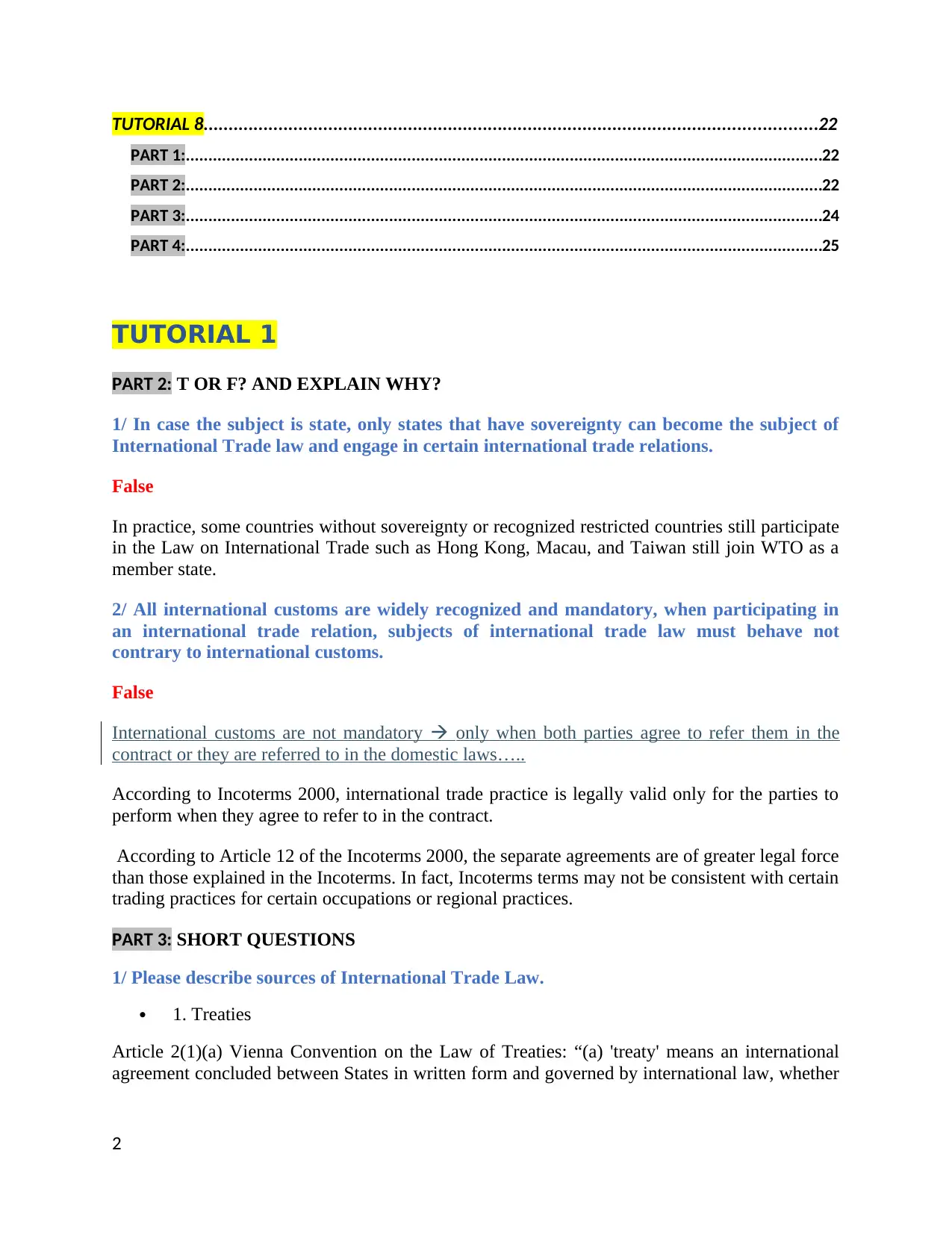
TUTORIAL 8...........................................................................................................................22
PART 1:.............................................................................................................................................22
PART 2:.............................................................................................................................................22
PART 3:.............................................................................................................................................24
PART 4:.............................................................................................................................................25
TUTORIAL 1
PART 2: T OR F? AND EXPLAIN WHY?
1/ In case the subject is state, only states that have sovereignty can become the subject of
International Trade law and engage in certain international trade relations.
False
In practice, some countries without sovereignty or recognized restricted countries still participate
in the Law on International Trade such as Hong Kong, Macau, and Taiwan still join WTO as a
member state.
2/ All international customs are widely recognized and mandatory, when participating in
an international trade relation, subjects of international trade law must behave not
contrary to international customs.
False
International customs are not mandatory only when both parties agree to refer them in the
contract or they are referred to in the domestic laws…..
According to Incoterms 2000, international trade practice is legally valid only for the parties to
perform when they agree to refer to in the contract.
According to Article 12 of the Incoterms 2000, the separate agreements are of greater legal force
than those explained in the Incoterms. In fact, Incoterms terms may not be consistent with certain
trading practices for certain occupations or regional practices.
PART 3: SHORT QUESTIONS
1/ Please describe sources of International Trade Law.
1. Treaties
Article 2(1)(a) Vienna Convention on the Law of Treaties: “(a) 'treaty' means an international
agreement concluded between States in written form and governed by international law, whether
2
PART 1:.............................................................................................................................................22
PART 2:.............................................................................................................................................22
PART 3:.............................................................................................................................................24
PART 4:.............................................................................................................................................25
TUTORIAL 1
PART 2: T OR F? AND EXPLAIN WHY?
1/ In case the subject is state, only states that have sovereignty can become the subject of
International Trade law and engage in certain international trade relations.
False
In practice, some countries without sovereignty or recognized restricted countries still participate
in the Law on International Trade such as Hong Kong, Macau, and Taiwan still join WTO as a
member state.
2/ All international customs are widely recognized and mandatory, when participating in
an international trade relation, subjects of international trade law must behave not
contrary to international customs.
False
International customs are not mandatory only when both parties agree to refer them in the
contract or they are referred to in the domestic laws…..
According to Incoterms 2000, international trade practice is legally valid only for the parties to
perform when they agree to refer to in the contract.
According to Article 12 of the Incoterms 2000, the separate agreements are of greater legal force
than those explained in the Incoterms. In fact, Incoterms terms may not be consistent with certain
trading practices for certain occupations or regional practices.
PART 3: SHORT QUESTIONS
1/ Please describe sources of International Trade Law.
1. Treaties
Article 2(1)(a) Vienna Convention on the Law of Treaties: “(a) 'treaty' means an international
agreement concluded between States in written form and governed by international law, whether
2
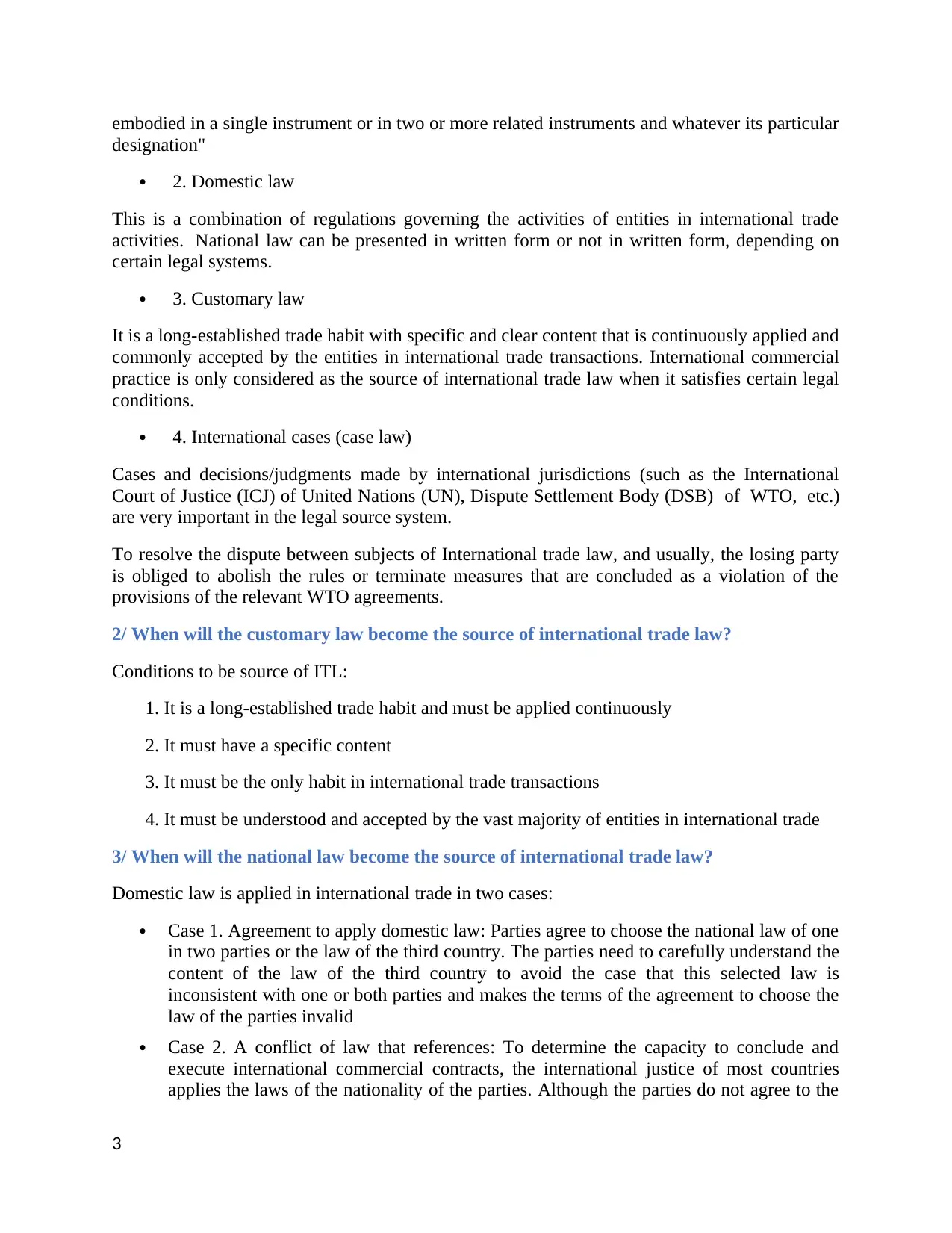
embodied in a single instrument or in two or more related instruments and whatever its particular
designation"
2. Domestic law
This is a combination of regulations governing the activities of entities in international trade
activities. National law can be presented in written form or not in written form, depending on
certain legal systems.
3. Customary law
It is a long-established trade habit with specific and clear content that is continuously applied and
commonly accepted by the entities in international trade transactions. International commercial
practice is only considered as the source of international trade law when it satisfies certain legal
conditions.
4. International cases (case law)
Cases and decisions/judgments made by international jurisdictions (such as the International
Court of Justice (ICJ) of United Nations (UN), Dispute Settlement Body (DSB) of WTO, etc.)
are very important in the legal source system.
To resolve the dispute between subjects of International trade law, and usually, the losing party
is obliged to abolish the rules or terminate measures that are concluded as a violation of the
provisions of the relevant WTO agreements.
2/ When will the customary law become the source of international trade law?
Conditions to be source of ITL:
1. It is a long-established trade habit and must be applied continuously
2. It must have a specific content
3. It must be the only habit in international trade transactions
4. It must be understood and accepted by the vast majority of entities in international trade
3/ When will the national law become the source of international trade law?
Domestic law is applied in international trade in two cases:
Case 1. Agreement to apply domestic law: Parties agree to choose the national law of one
in two parties or the law of the third country. The parties need to carefully understand the
content of the law of the third country to avoid the case that this selected law is
inconsistent with one or both parties and makes the terms of the agreement to choose the
law of the parties invalid
Case 2. A conflict of law that references: To determine the capacity to conclude and
execute international commercial contracts, the international justice of most countries
applies the laws of the nationality of the parties. Although the parties do not agree to the
3
designation"
2. Domestic law
This is a combination of regulations governing the activities of entities in international trade
activities. National law can be presented in written form or not in written form, depending on
certain legal systems.
3. Customary law
It is a long-established trade habit with specific and clear content that is continuously applied and
commonly accepted by the entities in international trade transactions. International commercial
practice is only considered as the source of international trade law when it satisfies certain legal
conditions.
4. International cases (case law)
Cases and decisions/judgments made by international jurisdictions (such as the International
Court of Justice (ICJ) of United Nations (UN), Dispute Settlement Body (DSB) of WTO, etc.)
are very important in the legal source system.
To resolve the dispute between subjects of International trade law, and usually, the losing party
is obliged to abolish the rules or terminate measures that are concluded as a violation of the
provisions of the relevant WTO agreements.
2/ When will the customary law become the source of international trade law?
Conditions to be source of ITL:
1. It is a long-established trade habit and must be applied continuously
2. It must have a specific content
3. It must be the only habit in international trade transactions
4. It must be understood and accepted by the vast majority of entities in international trade
3/ When will the national law become the source of international trade law?
Domestic law is applied in international trade in two cases:
Case 1. Agreement to apply domestic law: Parties agree to choose the national law of one
in two parties or the law of the third country. The parties need to carefully understand the
content of the law of the third country to avoid the case that this selected law is
inconsistent with one or both parties and makes the terms of the agreement to choose the
law of the parties invalid
Case 2. A conflict of law that references: To determine the capacity to conclude and
execute international commercial contracts, the international justice of most countries
applies the laws of the nationality of the parties. Although the parties do not agree to the
3
⊘ This is a preview!⊘
Do you want full access?
Subscribe today to unlock all pages.

Trusted by 1+ million students worldwide
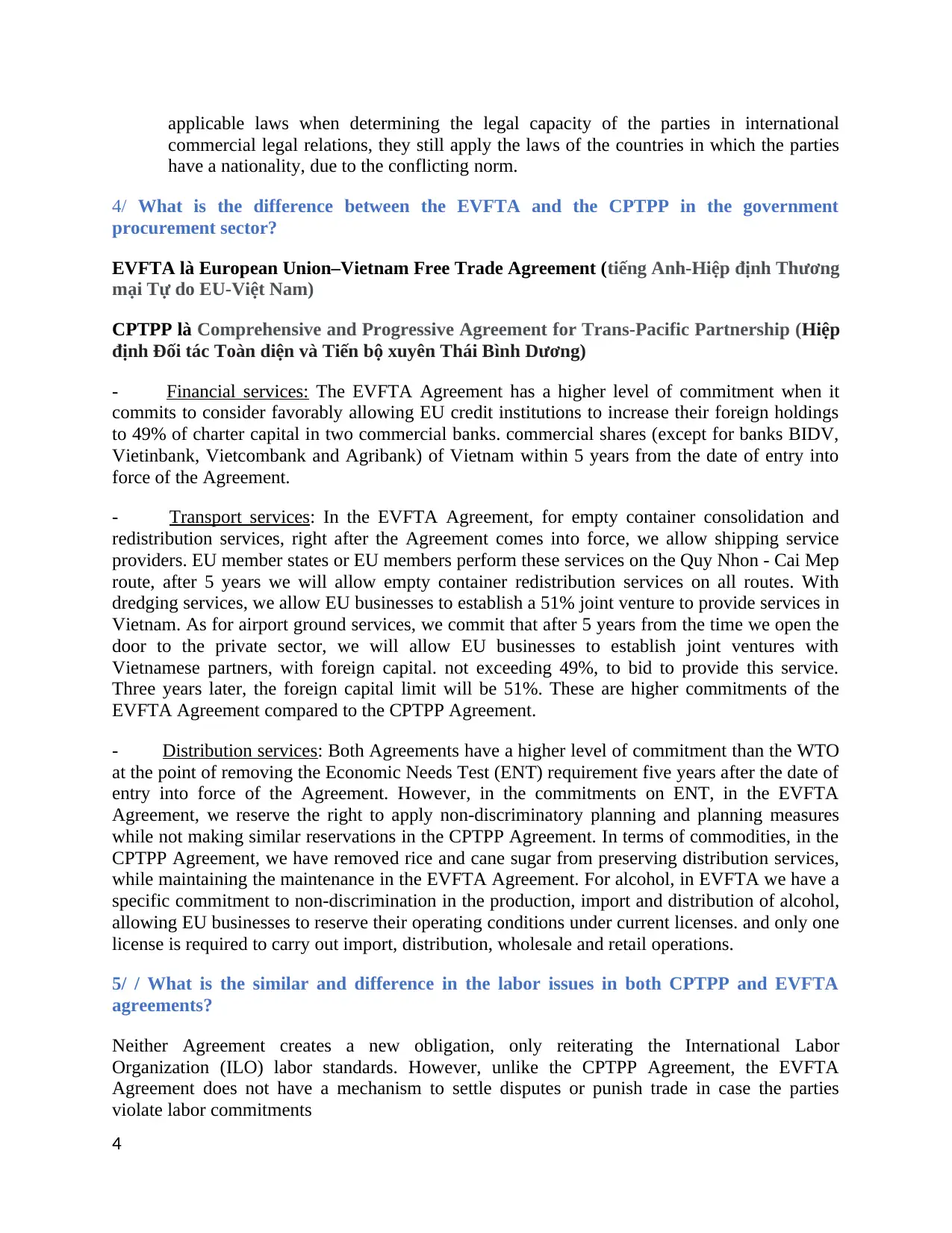
applicable laws when determining the legal capacity of the parties in international
commercial legal relations, they still apply the laws of the countries in which the parties
have a nationality, due to the conflicting norm.
4/ What is the difference between the EVFTA and the CPTPP in the government
procurement sector?
EVFTA là European Union–Vietnam Free Trade Agreement (tiếng Anh-Hiệp định Thương
mại Tự do EU-Việt Nam)
CPTPP là Comprehensive and Progressive Agreement for Trans-Pacific Partnership (Hiệp
định Đối tác Toàn diện và Tiến bộ xuyên Thái Bình Dương)
- Financial services: The EVFTA Agreement has a higher level of commitment when it
commits to consider favorably allowing EU credit institutions to increase their foreign holdings
to 49% of charter capital in two commercial banks. commercial shares (except for banks BIDV,
Vietinbank, Vietcombank and Agribank) of Vietnam within 5 years from the date of entry into
force of the Agreement.
- Transport services: In the EVFTA Agreement, for empty container consolidation and
redistribution services, right after the Agreement comes into force, we allow shipping service
providers. EU member states or EU members perform these services on the Quy Nhon - Cai Mep
route, after 5 years we will allow empty container redistribution services on all routes. With
dredging services, we allow EU businesses to establish a 51% joint venture to provide services in
Vietnam. As for airport ground services, we commit that after 5 years from the time we open the
door to the private sector, we will allow EU businesses to establish joint ventures with
Vietnamese partners, with foreign capital. not exceeding 49%, to bid to provide this service.
Three years later, the foreign capital limit will be 51%. These are higher commitments of the
EVFTA Agreement compared to the CPTPP Agreement.
- Distribution services: Both Agreements have a higher level of commitment than the WTO
at the point of removing the Economic Needs Test (ENT) requirement five years after the date of
entry into force of the Agreement. However, in the commitments on ENT, in the EVFTA
Agreement, we reserve the right to apply non-discriminatory planning and planning measures
while not making similar reservations in the CPTPP Agreement. In terms of commodities, in the
CPTPP Agreement, we have removed rice and cane sugar from preserving distribution services,
while maintaining the maintenance in the EVFTA Agreement. For alcohol, in EVFTA we have a
specific commitment to non-discrimination in the production, import and distribution of alcohol,
allowing EU businesses to reserve their operating conditions under current licenses. and only one
license is required to carry out import, distribution, wholesale and retail operations.
5/ / What is the similar and difference in the labor issues in both CPTPP and EVFTA
agreements?
Neither Agreement creates a new obligation, only reiterating the International Labor
Organization (ILO) labor standards. However, unlike the CPTPP Agreement, the EVFTA
Agreement does not have a mechanism to settle disputes or punish trade in case the parties
violate labor commitments
4
commercial legal relations, they still apply the laws of the countries in which the parties
have a nationality, due to the conflicting norm.
4/ What is the difference between the EVFTA and the CPTPP in the government
procurement sector?
EVFTA là European Union–Vietnam Free Trade Agreement (tiếng Anh-Hiệp định Thương
mại Tự do EU-Việt Nam)
CPTPP là Comprehensive and Progressive Agreement for Trans-Pacific Partnership (Hiệp
định Đối tác Toàn diện và Tiến bộ xuyên Thái Bình Dương)
- Financial services: The EVFTA Agreement has a higher level of commitment when it
commits to consider favorably allowing EU credit institutions to increase their foreign holdings
to 49% of charter capital in two commercial banks. commercial shares (except for banks BIDV,
Vietinbank, Vietcombank and Agribank) of Vietnam within 5 years from the date of entry into
force of the Agreement.
- Transport services: In the EVFTA Agreement, for empty container consolidation and
redistribution services, right after the Agreement comes into force, we allow shipping service
providers. EU member states or EU members perform these services on the Quy Nhon - Cai Mep
route, after 5 years we will allow empty container redistribution services on all routes. With
dredging services, we allow EU businesses to establish a 51% joint venture to provide services in
Vietnam. As for airport ground services, we commit that after 5 years from the time we open the
door to the private sector, we will allow EU businesses to establish joint ventures with
Vietnamese partners, with foreign capital. not exceeding 49%, to bid to provide this service.
Three years later, the foreign capital limit will be 51%. These are higher commitments of the
EVFTA Agreement compared to the CPTPP Agreement.
- Distribution services: Both Agreements have a higher level of commitment than the WTO
at the point of removing the Economic Needs Test (ENT) requirement five years after the date of
entry into force of the Agreement. However, in the commitments on ENT, in the EVFTA
Agreement, we reserve the right to apply non-discriminatory planning and planning measures
while not making similar reservations in the CPTPP Agreement. In terms of commodities, in the
CPTPP Agreement, we have removed rice and cane sugar from preserving distribution services,
while maintaining the maintenance in the EVFTA Agreement. For alcohol, in EVFTA we have a
specific commitment to non-discrimination in the production, import and distribution of alcohol,
allowing EU businesses to reserve their operating conditions under current licenses. and only one
license is required to carry out import, distribution, wholesale and retail operations.
5/ / What is the similar and difference in the labor issues in both CPTPP and EVFTA
agreements?
Neither Agreement creates a new obligation, only reiterating the International Labor
Organization (ILO) labor standards. However, unlike the CPTPP Agreement, the EVFTA
Agreement does not have a mechanism to settle disputes or punish trade in case the parties
violate labor commitments
4
Paraphrase This Document
Need a fresh take? Get an instant paraphrase of this document with our AI Paraphraser
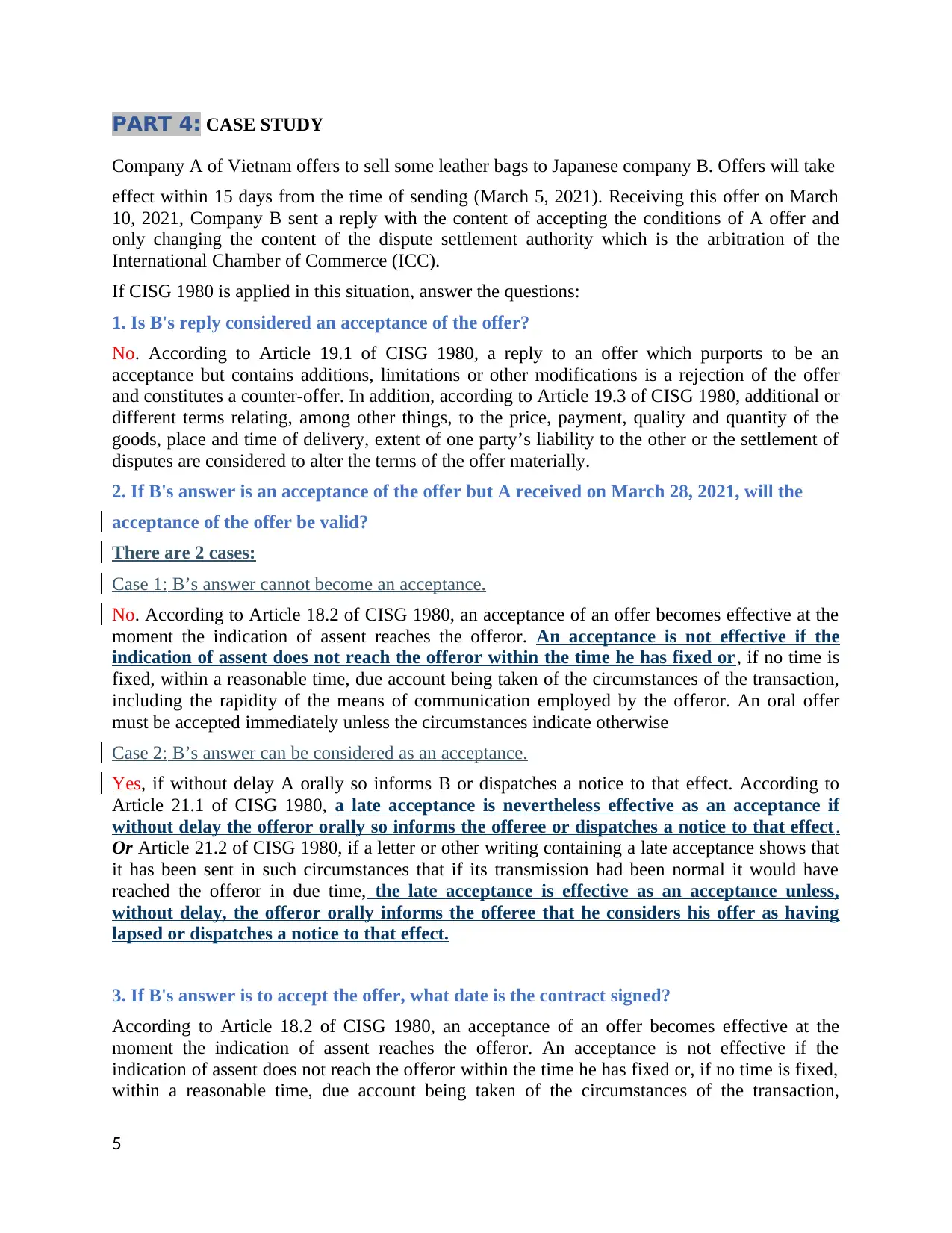
PART 4: CASE STUDY
Company A of Vietnam offers to sell some leather bags to Japanese company B. Offers will take
effect within 15 days from the time of sending (March 5, 2021). Receiving this offer on March
10, 2021, Company B sent a reply with the content of accepting the conditions of A offer and
only changing the content of the dispute settlement authority which is the arbitration of the
International Chamber of Commerce (ICC).
If CISG 1980 is applied in this situation, answer the questions:
1. Is B's reply considered an acceptance of the offer?
No. According to Article 19.1 of CISG 1980, a reply to an offer which purports to be an
acceptance but contains additions, limitations or other modifications is a rejection of the offer
and constitutes a counter-offer. In addition, according to Article 19.3 of CISG 1980, additional or
different terms relating, among other things, to the price, payment, quality and quantity of the
goods, place and time of delivery, extent of one party’s liability to the other or the settlement of
disputes are considered to alter the terms of the offer materially.
2. If B's answer is an acceptance of the offer but A received on March 28, 2021, will the
acceptance of the offer be valid?
There are 2 cases:
Case 1: B’s answer cannot become an acceptance.
No. According to Article 18.2 of CISG 1980, an acceptance of an offer becomes effective at the
moment the indication of assent reaches the offeror. An acceptance is not effective if the
indication of assent does not reach the offeror within the time he has fixed or, if no time is
fixed, within a reasonable time, due account being taken of the circumstances of the transaction,
including the rapidity of the means of communication employed by the offeror. An oral offer
must be accepted immediately unless the circumstances indicate otherwise
Case 2: B’s answer can be considered as an acceptance.
Yes, if without delay A orally so informs B or dispatches a notice to that effect. According to
Article 21.1 of CISG 1980, a late acceptance is nevertheless effective as an acceptance if
without delay the offeror orally so informs the offeree or dispatches a notice to that effect.
Or Article 21.2 of CISG 1980, if a letter or other writing containing a late acceptance shows that
it has been sent in such circumstances that if its transmission had been normal it would have
reached the offeror in due time, the late acceptance is effective as an acceptance unless,
without delay, the offeror orally informs the offeree that he considers his offer as having
lapsed or dispatches a notice to that effect.
3. If B's answer is to accept the offer, what date is the contract signed?
According to Article 18.2 of CISG 1980, an acceptance of an offer becomes effective at the
moment the indication of assent reaches the offeror. An acceptance is not effective if the
indication of assent does not reach the offeror within the time he has fixed or, if no time is fixed,
within a reasonable time, due account being taken of the circumstances of the transaction,
5
Company A of Vietnam offers to sell some leather bags to Japanese company B. Offers will take
effect within 15 days from the time of sending (March 5, 2021). Receiving this offer on March
10, 2021, Company B sent a reply with the content of accepting the conditions of A offer and
only changing the content of the dispute settlement authority which is the arbitration of the
International Chamber of Commerce (ICC).
If CISG 1980 is applied in this situation, answer the questions:
1. Is B's reply considered an acceptance of the offer?
No. According to Article 19.1 of CISG 1980, a reply to an offer which purports to be an
acceptance but contains additions, limitations or other modifications is a rejection of the offer
and constitutes a counter-offer. In addition, according to Article 19.3 of CISG 1980, additional or
different terms relating, among other things, to the price, payment, quality and quantity of the
goods, place and time of delivery, extent of one party’s liability to the other or the settlement of
disputes are considered to alter the terms of the offer materially.
2. If B's answer is an acceptance of the offer but A received on March 28, 2021, will the
acceptance of the offer be valid?
There are 2 cases:
Case 1: B’s answer cannot become an acceptance.
No. According to Article 18.2 of CISG 1980, an acceptance of an offer becomes effective at the
moment the indication of assent reaches the offeror. An acceptance is not effective if the
indication of assent does not reach the offeror within the time he has fixed or, if no time is
fixed, within a reasonable time, due account being taken of the circumstances of the transaction,
including the rapidity of the means of communication employed by the offeror. An oral offer
must be accepted immediately unless the circumstances indicate otherwise
Case 2: B’s answer can be considered as an acceptance.
Yes, if without delay A orally so informs B or dispatches a notice to that effect. According to
Article 21.1 of CISG 1980, a late acceptance is nevertheless effective as an acceptance if
without delay the offeror orally so informs the offeree or dispatches a notice to that effect.
Or Article 21.2 of CISG 1980, if a letter or other writing containing a late acceptance shows that
it has been sent in such circumstances that if its transmission had been normal it would have
reached the offeror in due time, the late acceptance is effective as an acceptance unless,
without delay, the offeror orally informs the offeree that he considers his offer as having
lapsed or dispatches a notice to that effect.
3. If B's answer is to accept the offer, what date is the contract signed?
According to Article 18.2 of CISG 1980, an acceptance of an offer becomes effective at the
moment the indication of assent reaches the offeror. An acceptance is not effective if the
indication of assent does not reach the offeror within the time he has fixed or, if no time is fixed,
within a reasonable time, due account being taken of the circumstances of the transaction,
5
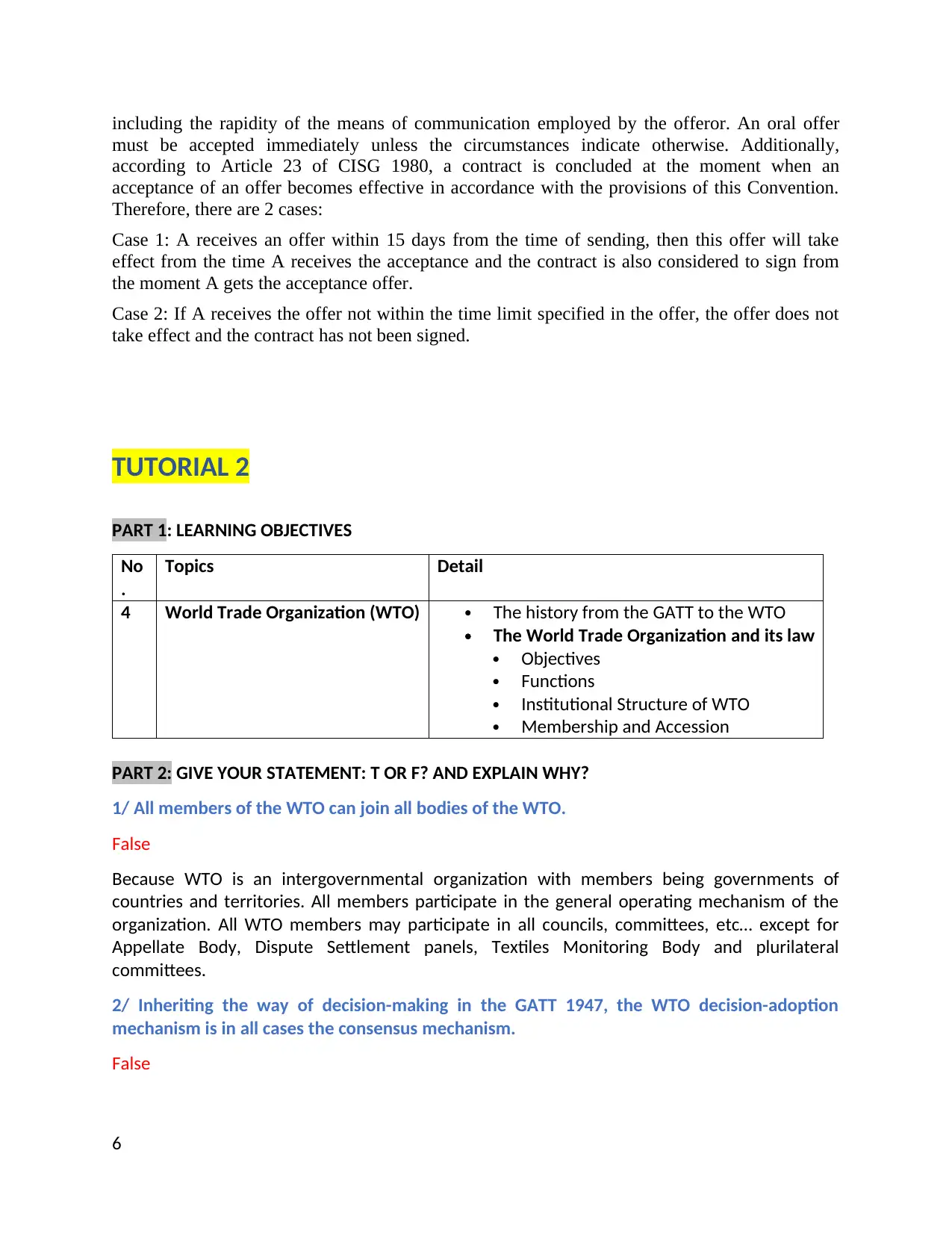
including the rapidity of the means of communication employed by the offeror. An oral offer
must be accepted immediately unless the circumstances indicate otherwise. Additionally,
according to Article 23 of CISG 1980, a contract is concluded at the moment when an
acceptance of an offer becomes effective in accordance with the provisions of this Convention.
Therefore, there are 2 cases:
Case 1: A receives an offer within 15 days from the time of sending, then this offer will take
effect from the time A receives the acceptance and the contract is also considered to sign from
the moment A gets the acceptance offer.
Case 2: If A receives the offer not within the time limit specified in the offer, the offer does not
take effect and the contract has not been signed.
TUTORIAL 2
PART 1: LEARNING OBJECTIVES
No
.
Topics Detail
4 World Trade Organization (WTO) The history from the GATT to the WTO
The World Trade Organization and its law
Objectives
Functions
Institutional Structure of WTO
Membership and Accession
PART 2: GIVE YOUR STATEMENT: T OR F? AND EXPLAIN WHY?
1/ All members of the WTO can join all bodies of the WTO.
False
Because WTO is an intergovernmental organization with members being governments of
countries and territories. All members participate in the general operating mechanism of the
organization. All WTO members may participate in all councils, committees, etc… except for
Appellate Body, Dispute Settlement panels, Textiles Monitoring Body and plurilateral
committees.
2/ Inheriting the way of decision-making in the GATT 1947, the WTO decision-adoption
mechanism is in all cases the consensus mechanism.
False
6
must be accepted immediately unless the circumstances indicate otherwise. Additionally,
according to Article 23 of CISG 1980, a contract is concluded at the moment when an
acceptance of an offer becomes effective in accordance with the provisions of this Convention.
Therefore, there are 2 cases:
Case 1: A receives an offer within 15 days from the time of sending, then this offer will take
effect from the time A receives the acceptance and the contract is also considered to sign from
the moment A gets the acceptance offer.
Case 2: If A receives the offer not within the time limit specified in the offer, the offer does not
take effect and the contract has not been signed.
TUTORIAL 2
PART 1: LEARNING OBJECTIVES
No
.
Topics Detail
4 World Trade Organization (WTO) The history from the GATT to the WTO
The World Trade Organization and its law
Objectives
Functions
Institutional Structure of WTO
Membership and Accession
PART 2: GIVE YOUR STATEMENT: T OR F? AND EXPLAIN WHY?
1/ All members of the WTO can join all bodies of the WTO.
False
Because WTO is an intergovernmental organization with members being governments of
countries and territories. All members participate in the general operating mechanism of the
organization. All WTO members may participate in all councils, committees, etc… except for
Appellate Body, Dispute Settlement panels, Textiles Monitoring Body and plurilateral
committees.
2/ Inheriting the way of decision-making in the GATT 1947, the WTO decision-adoption
mechanism is in all cases the consensus mechanism.
False
6
⊘ This is a preview!⊘
Do you want full access?
Subscribe today to unlock all pages.

Trusted by 1+ million students worldwide
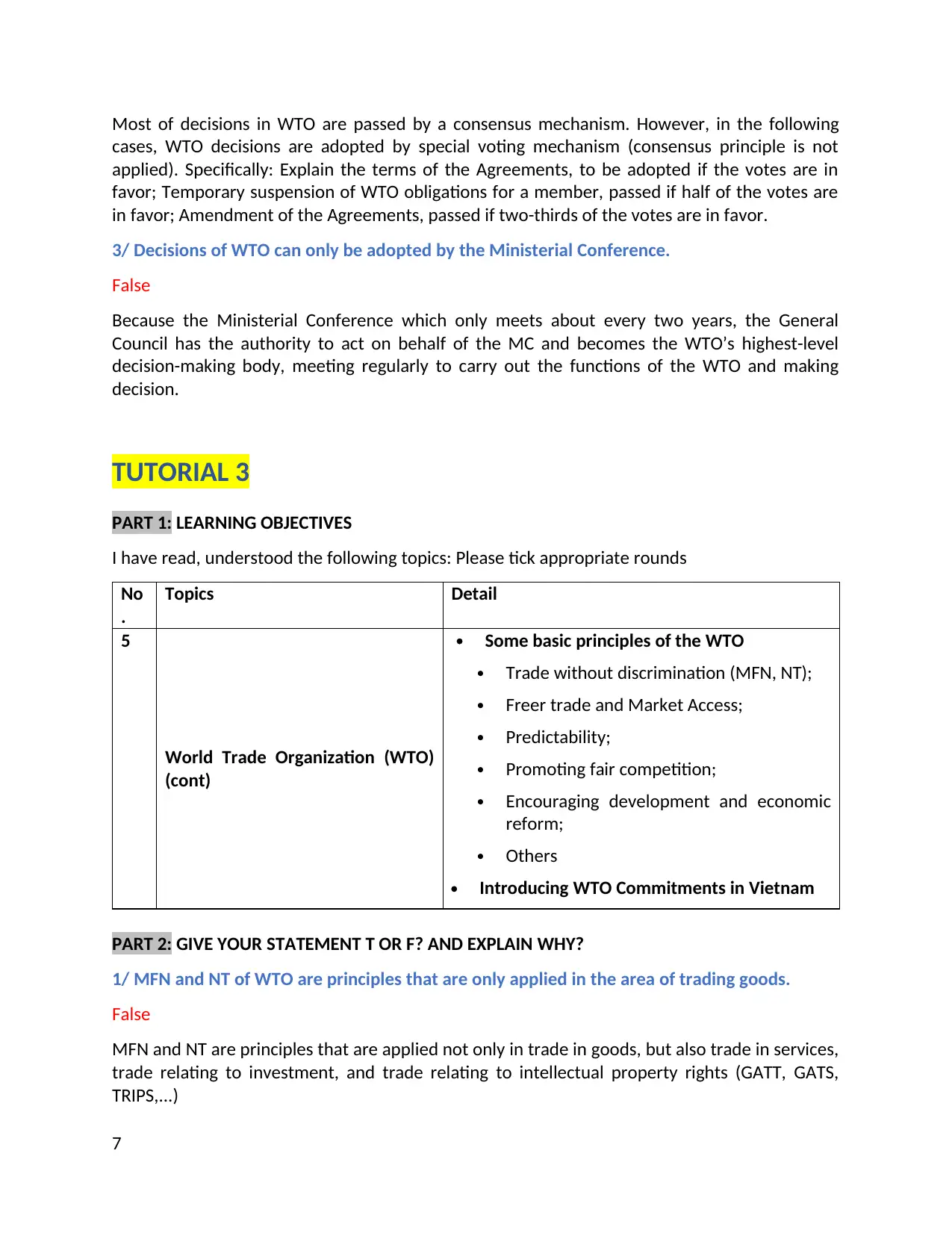
Most of decisions in WTO are passed by a consensus mechanism. However, in the following
cases, WTO decisions are adopted by special voting mechanism (consensus principle is not
applied). Specifically: Explain the terms of the Agreements, to be adopted if the votes are in
favor; Temporary suspension of WTO obligations for a member, passed if half of the votes are
in favor; Amendment of the Agreements, passed if two-thirds of the votes are in favor.
3/ Decisions of WTO can only be adopted by the Ministerial Conference.
False
Because the Ministerial Conference which only meets about every two years, the General
Council has the authority to act on behalf of the MC and becomes the WTO’s highest-level
decision-making body, meeting regularly to carry out the functions of the WTO and making
decision.
TUTORIAL 3
PART 1: LEARNING OBJECTIVES
I have read, understood the following topics: Please tick appropriate rounds
No
.
Topics Detail
5
World Trade Organization (WTO)
(cont)
Some basic principles of the WTO
Trade without discrimination (MFN, NT);
Freer trade and Market Access;
Predictability;
Promoting fair competition;
Encouraging development and economic
reform;
Others
Introducing WTO Commitments in Vietnam
PART 2: GIVE YOUR STATEMENT T OR F? AND EXPLAIN WHY?
1/ MFN and NT of WTO are principles that are only applied in the area of trading goods.
False
MFN and NT are principles that are applied not only in trade in goods, but also trade in services,
trade relating to investment, and trade relating to intellectual property rights (GATT, GATS,
TRIPS,...)
7
cases, WTO decisions are adopted by special voting mechanism (consensus principle is not
applied). Specifically: Explain the terms of the Agreements, to be adopted if the votes are in
favor; Temporary suspension of WTO obligations for a member, passed if half of the votes are
in favor; Amendment of the Agreements, passed if two-thirds of the votes are in favor.
3/ Decisions of WTO can only be adopted by the Ministerial Conference.
False
Because the Ministerial Conference which only meets about every two years, the General
Council has the authority to act on behalf of the MC and becomes the WTO’s highest-level
decision-making body, meeting regularly to carry out the functions of the WTO and making
decision.
TUTORIAL 3
PART 1: LEARNING OBJECTIVES
I have read, understood the following topics: Please tick appropriate rounds
No
.
Topics Detail
5
World Trade Organization (WTO)
(cont)
Some basic principles of the WTO
Trade without discrimination (MFN, NT);
Freer trade and Market Access;
Predictability;
Promoting fair competition;
Encouraging development and economic
reform;
Others
Introducing WTO Commitments in Vietnam
PART 2: GIVE YOUR STATEMENT T OR F? AND EXPLAIN WHY?
1/ MFN and NT of WTO are principles that are only applied in the area of trading goods.
False
MFN and NT are principles that are applied not only in trade in goods, but also trade in services,
trade relating to investment, and trade relating to intellectual property rights (GATT, GATS,
TRIPS,...)
7
Paraphrase This Document
Need a fresh take? Get an instant paraphrase of this document with our AI Paraphraser
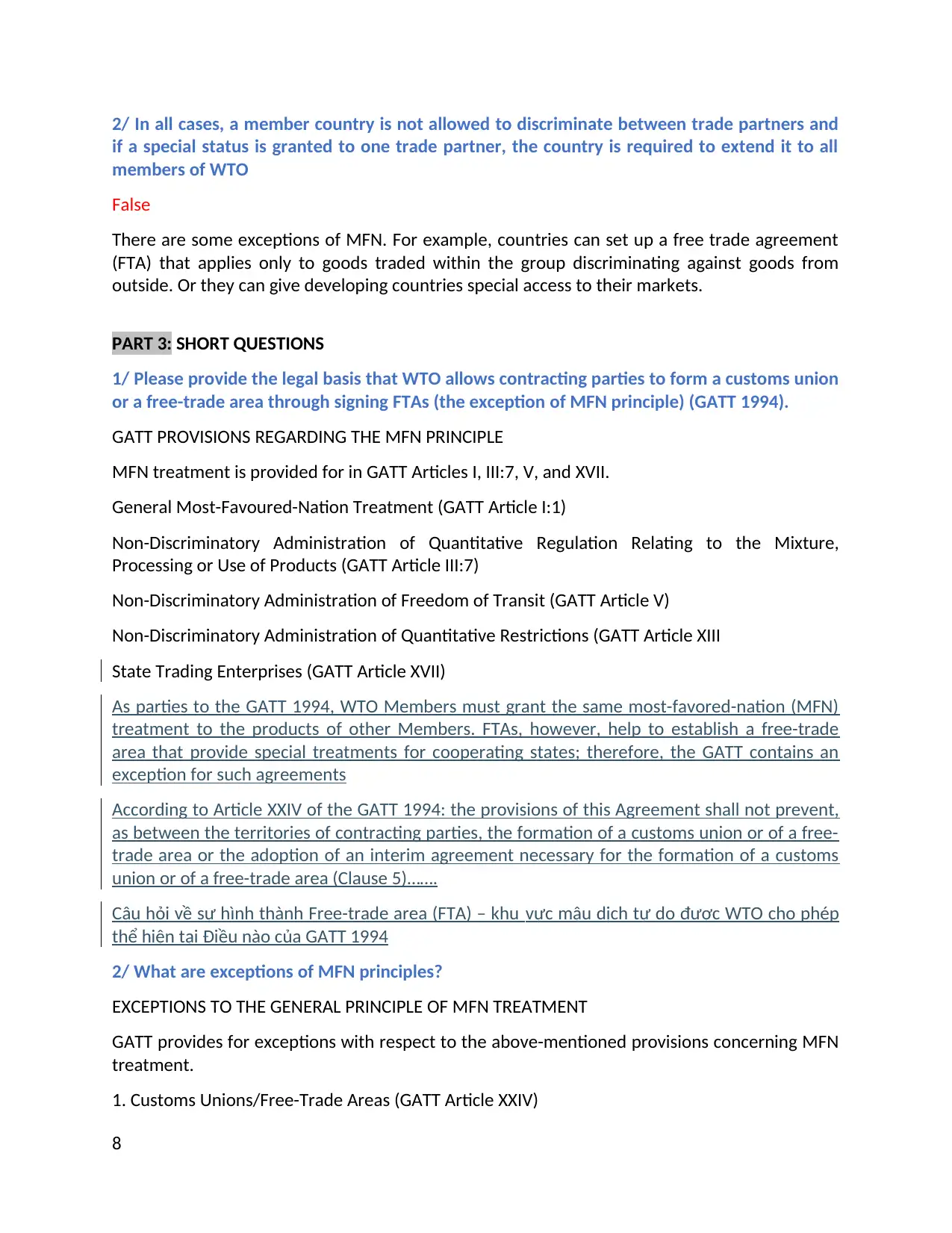
2/ In all cases, a member country is not allowed to discriminate between trade partners and
if a special status is granted to one trade partner, the country is required to extend it to all
members of WTO
False
There are some exceptions of MFN. For example, countries can set up a free trade agreement
(FTA) that applies only to goods traded within the group discriminating against goods from
outside. Or they can give developing countries special access to their markets.
PART 3: SHORT QUESTIONS
1/ Please provide the legal basis that WTO allows contracting parties to form a customs union
or a free-trade area through signing FTAs (the exception of MFN principle) (GATT 1994).
GATT PROVISIONS REGARDING THE MFN PRINCIPLE
MFN treatment is provided for in GATT Articles I, III:7, V, and XVII.
General Most-Favoured-Nation Treatment (GATT Article I:1)
Non-Discriminatory Administration of Quantitative Regulation Relating to the Mixture,
Processing or Use of Products (GATT Article III:7)
Non-Discriminatory Administration of Freedom of Transit (GATT Article V)
Non-Discriminatory Administration of Quantitative Restrictions (GATT Article XIII
State Trading Enterprises (GATT Article XVII)
As parties to the GATT 1994, WTO Members must grant the same most-favored-nation (MFN)
treatment to the products of other Members. FTAs, however, help to establish a free-trade
area that provide special treatments for cooperating states; therefore, the GATT contains an
exception for such agreements
According to Article XXIV of the GATT 1994: the provisions of this Agreement shall not prevent,
as between the territories of contracting parties, the formation of a customs union or of a free-
trade area or the adoption of an interim agreement necessary for the formation of a customs
union or of a free-trade area (Clause 5)…….
Câu hỏi về sự hình thành Free-trade area (FTA) – khu vực mậu dịch tự do được WTO cho phép
thể hiện tại Điều nào của GATT 1994
2/ What are exceptions of MFN principles?
EXCEPTIONS TO THE GENERAL PRINCIPLE OF MFN TREATMENT
GATT provides for exceptions with respect to the above-mentioned provisions concerning MFN
treatment.
1. Customs Unions/Free-Trade Areas (GATT Article XXIV)
8
if a special status is granted to one trade partner, the country is required to extend it to all
members of WTO
False
There are some exceptions of MFN. For example, countries can set up a free trade agreement
(FTA) that applies only to goods traded within the group discriminating against goods from
outside. Or they can give developing countries special access to their markets.
PART 3: SHORT QUESTIONS
1/ Please provide the legal basis that WTO allows contracting parties to form a customs union
or a free-trade area through signing FTAs (the exception of MFN principle) (GATT 1994).
GATT PROVISIONS REGARDING THE MFN PRINCIPLE
MFN treatment is provided for in GATT Articles I, III:7, V, and XVII.
General Most-Favoured-Nation Treatment (GATT Article I:1)
Non-Discriminatory Administration of Quantitative Regulation Relating to the Mixture,
Processing or Use of Products (GATT Article III:7)
Non-Discriminatory Administration of Freedom of Transit (GATT Article V)
Non-Discriminatory Administration of Quantitative Restrictions (GATT Article XIII
State Trading Enterprises (GATT Article XVII)
As parties to the GATT 1994, WTO Members must grant the same most-favored-nation (MFN)
treatment to the products of other Members. FTAs, however, help to establish a free-trade
area that provide special treatments for cooperating states; therefore, the GATT contains an
exception for such agreements
According to Article XXIV of the GATT 1994: the provisions of this Agreement shall not prevent,
as between the territories of contracting parties, the formation of a customs union or of a free-
trade area or the adoption of an interim agreement necessary for the formation of a customs
union or of a free-trade area (Clause 5)…….
Câu hỏi về sự hình thành Free-trade area (FTA) – khu vực mậu dịch tự do được WTO cho phép
thể hiện tại Điều nào của GATT 1994
2/ What are exceptions of MFN principles?
EXCEPTIONS TO THE GENERAL PRINCIPLE OF MFN TREATMENT
GATT provides for exceptions with respect to the above-mentioned provisions concerning MFN
treatment.
1. Customs Unions/Free-Trade Areas (GATT Article XXIV)
8
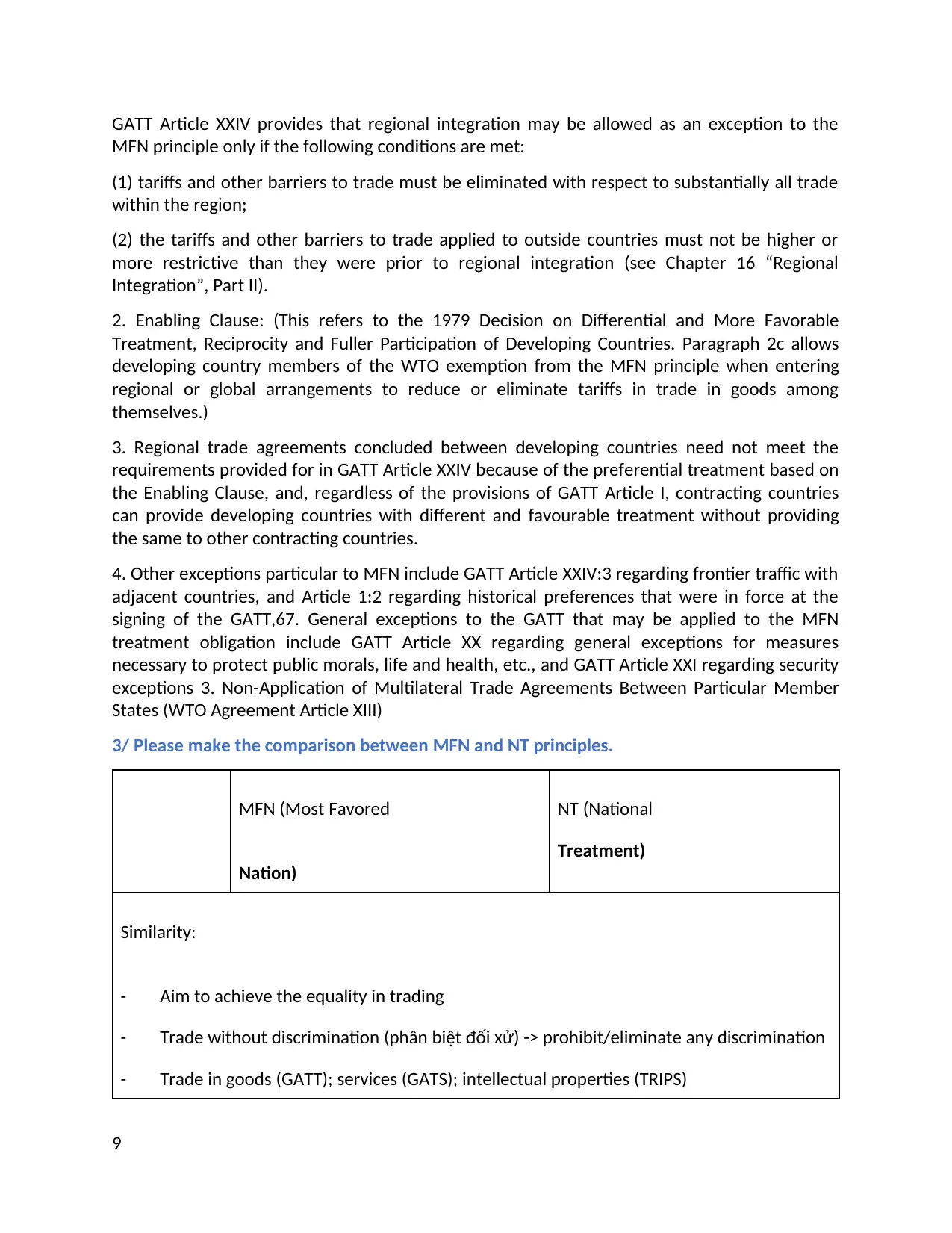
GATT Article XXIV provides that regional integration may be allowed as an exception to the
MFN principle only if the following conditions are met:
(1) tariffs and other barriers to trade must be eliminated with respect to substantially all trade
within the region;
(2) the tariffs and other barriers to trade applied to outside countries must not be higher or
more restrictive than they were prior to regional integration (see Chapter 16 “Regional
Integration”, Part II).
2. Enabling Clause: (This refers to the 1979 Decision on Differential and More Favorable
Treatment, Reciprocity and Fuller Participation of Developing Countries. Paragraph 2c allows
developing country members of the WTO exemption from the MFN principle when entering
regional or global arrangements to reduce or eliminate tariffs in trade in goods among
themselves.)
3. Regional trade agreements concluded between developing countries need not meet the
requirements provided for in GATT Article XXIV because of the preferential treatment based on
the Enabling Clause, and, regardless of the provisions of GATT Article I, contracting countries
can provide developing countries with different and favourable treatment without providing
the same to other contracting countries.
4. Other exceptions particular to MFN include GATT Article XXIV:3 regarding frontier traffic with
adjacent countries, and Article 1:2 regarding historical preferences that were in force at the
signing of the GATT,67. General exceptions to the GATT that may be applied to the MFN
treatment obligation include GATT Article XX regarding general exceptions for measures
necessary to protect public morals, life and health, etc., and GATT Article XXI regarding security
exceptions 3. Non-Application of Multilateral Trade Agreements Between Particular Member
States (WTO Agreement Article XIII)
3/ Please make the comparison between MFN and NT principles.
MFN (Most Favored
Nation)
NT (National
Treatment)
Similarity:
- Aim to achieve the equality in trading
- Trade without discrimination (phân biệt đối xử) -> prohibit/eliminate any discrimination
- Trade in goods (GATT); services (GATS); intellectual properties (TRIPS)
9
MFN principle only if the following conditions are met:
(1) tariffs and other barriers to trade must be eliminated with respect to substantially all trade
within the region;
(2) the tariffs and other barriers to trade applied to outside countries must not be higher or
more restrictive than they were prior to regional integration (see Chapter 16 “Regional
Integration”, Part II).
2. Enabling Clause: (This refers to the 1979 Decision on Differential and More Favorable
Treatment, Reciprocity and Fuller Participation of Developing Countries. Paragraph 2c allows
developing country members of the WTO exemption from the MFN principle when entering
regional or global arrangements to reduce or eliminate tariffs in trade in goods among
themselves.)
3. Regional trade agreements concluded between developing countries need not meet the
requirements provided for in GATT Article XXIV because of the preferential treatment based on
the Enabling Clause, and, regardless of the provisions of GATT Article I, contracting countries
can provide developing countries with different and favourable treatment without providing
the same to other contracting countries.
4. Other exceptions particular to MFN include GATT Article XXIV:3 regarding frontier traffic with
adjacent countries, and Article 1:2 regarding historical preferences that were in force at the
signing of the GATT,67. General exceptions to the GATT that may be applied to the MFN
treatment obligation include GATT Article XX regarding general exceptions for measures
necessary to protect public morals, life and health, etc., and GATT Article XXI regarding security
exceptions 3. Non-Application of Multilateral Trade Agreements Between Particular Member
States (WTO Agreement Article XIII)
3/ Please make the comparison between MFN and NT principles.
MFN (Most Favored
Nation)
NT (National
Treatment)
Similarity:
- Aim to achieve the equality in trading
- Trade without discrimination (phân biệt đối xử) -> prohibit/eliminate any discrimination
- Trade in goods (GATT); services (GATS); intellectual properties (TRIPS)
9
⊘ This is a preview!⊘
Do you want full access?
Subscribe today to unlock all pages.

Trusted by 1+ million students worldwide
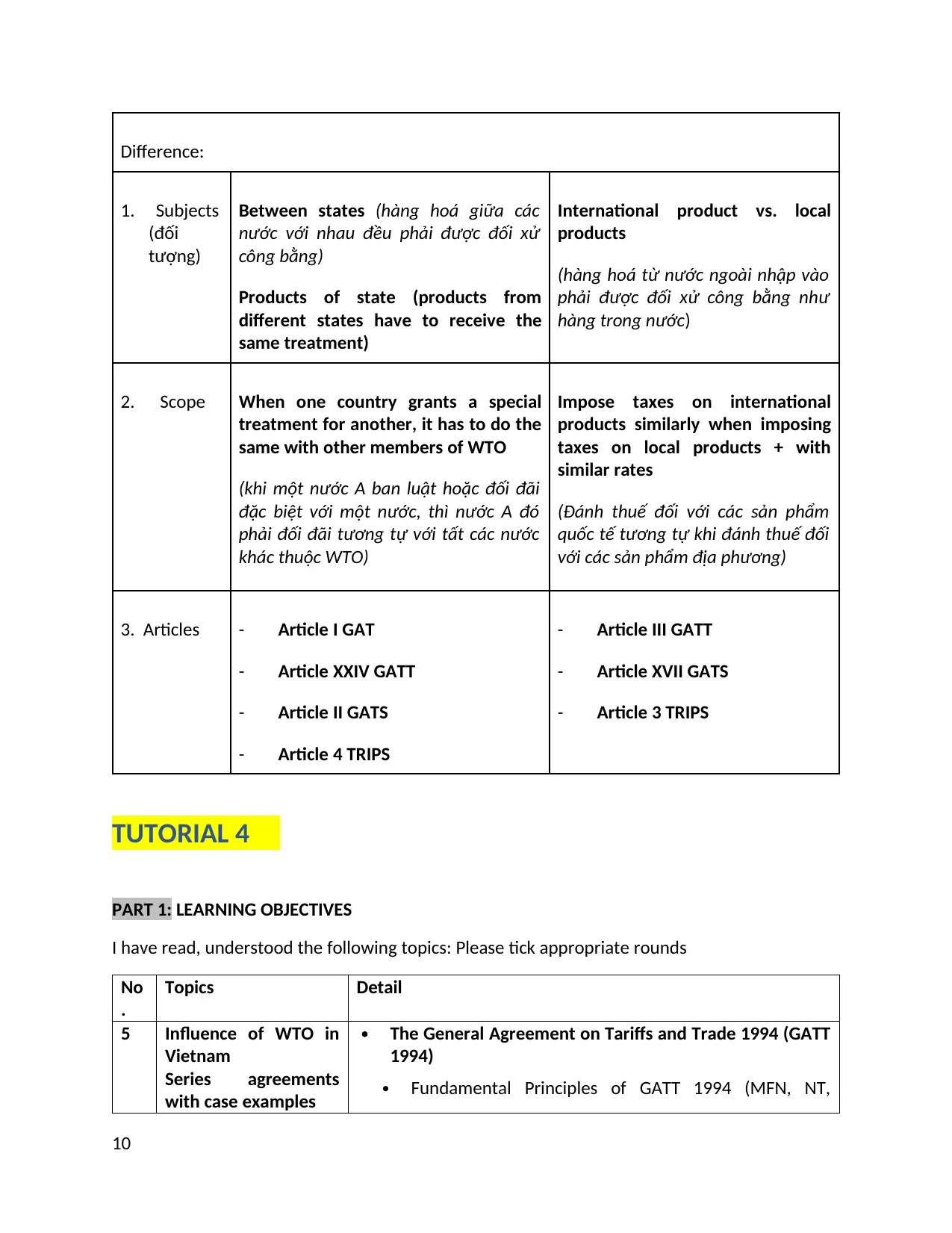
Difference:
1. Subjects
(đối
tượng)
Between states (hàng hoá giữa các
nước với nhau đều phải được đối xử
công bằng)
Products of state (products from
different states have to receive the
same treatment)
International product vs. local
products
(hàng hoá từ nước ngoài nhập vào
phải được đối xử công bằng như
hàng trong nước)
2. Scope When one country grants a special
treatment for another, it has to do the
same with other members of WTO
(khi một nước A ban luật hoặc đối đãi
đặc biệt với một nước, thì nước A đó
phải đối đãi tương tự với tất các nước
khác thuộc WTO)
Impose taxes on international
products similarly when imposing
taxes on local products + with
similar rates
(Đánh thuế đối với các sản phẩm
quốc tế tương tự khi đánh thuế đối
với các sản phẩm địa phương)
3. Articles - Article I GAT
- Article XXIV GATT
- Article II GATS
- Article 4 TRIPS
- Article III GATT
- Article XVII GATS
- Article 3 TRIPS
TUTORIAL 4
PART 1: LEARNING OBJECTIVES
I have read, understood the following topics: Please tick appropriate rounds
No
.
Topics Detail
5 Influence of WTO in
Vietnam
Series agreements
with case examples
The General Agreement on Tariffs and Trade 1994 (GATT
1994)
Fundamental Principles of GATT 1994 (MFN, NT,
10
1. Subjects
(đối
tượng)
Between states (hàng hoá giữa các
nước với nhau đều phải được đối xử
công bằng)
Products of state (products from
different states have to receive the
same treatment)
International product vs. local
products
(hàng hoá từ nước ngoài nhập vào
phải được đối xử công bằng như
hàng trong nước)
2. Scope When one country grants a special
treatment for another, it has to do the
same with other members of WTO
(khi một nước A ban luật hoặc đối đãi
đặc biệt với một nước, thì nước A đó
phải đối đãi tương tự với tất các nước
khác thuộc WTO)
Impose taxes on international
products similarly when imposing
taxes on local products + with
similar rates
(Đánh thuế đối với các sản phẩm
quốc tế tương tự khi đánh thuế đối
với các sản phẩm địa phương)
3. Articles - Article I GAT
- Article XXIV GATT
- Article II GATS
- Article 4 TRIPS
- Article III GATT
- Article XVII GATS
- Article 3 TRIPS
TUTORIAL 4
PART 1: LEARNING OBJECTIVES
I have read, understood the following topics: Please tick appropriate rounds
No
.
Topics Detail
5 Influence of WTO in
Vietnam
Series agreements
with case examples
The General Agreement on Tariffs and Trade 1994 (GATT
1994)
Fundamental Principles of GATT 1994 (MFN, NT,
10
Paraphrase This Document
Need a fresh take? Get an instant paraphrase of this document with our AI Paraphraser
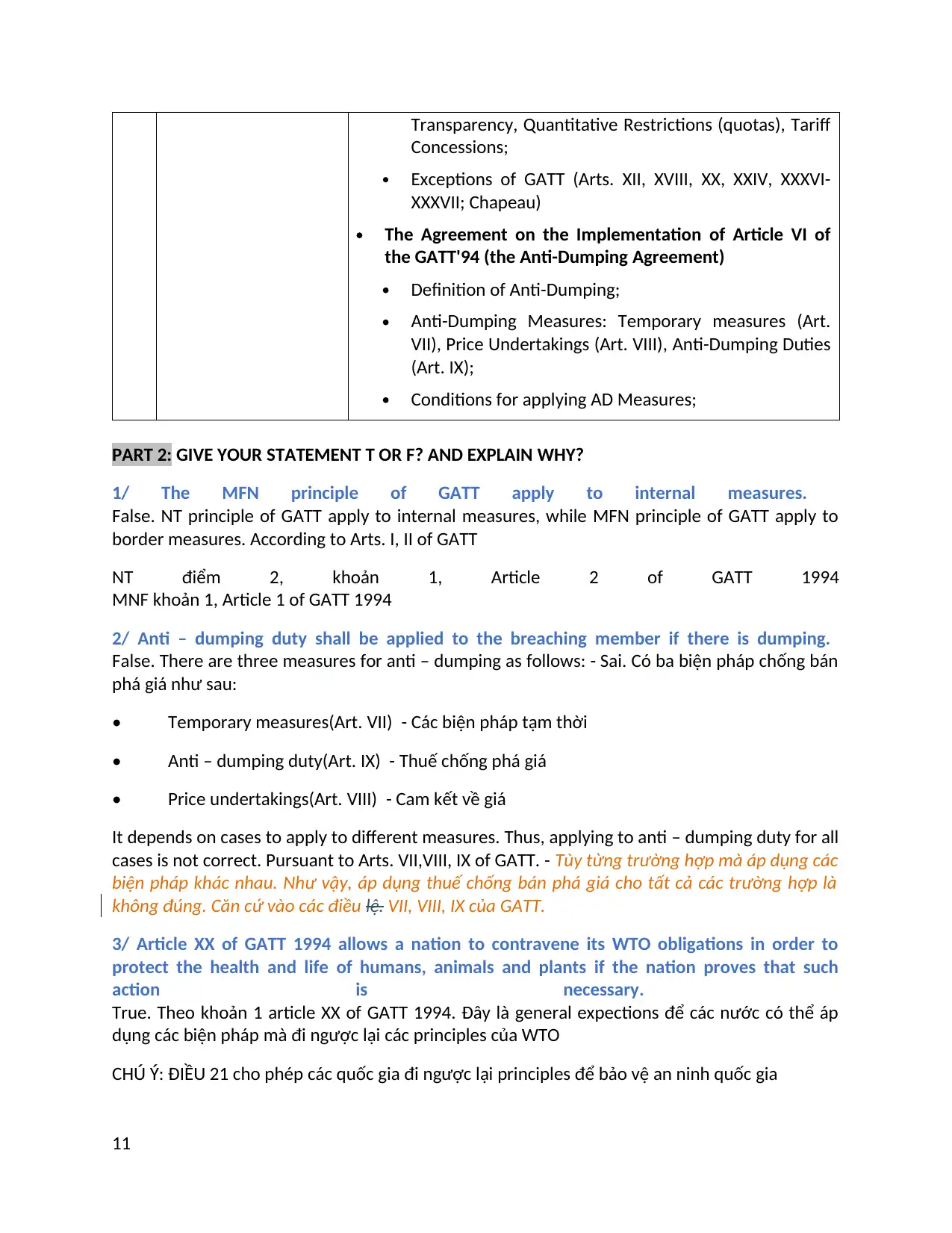
Transparency, Quantitative Restrictions (quotas), Tariff
Concessions;
Exceptions of GATT (Arts. XII, XVIII, XX, XXIV, XXXVI-
XXXVII; Chapeau)
The Agreement on the Implementation of Article VI of
the GATT'94 (the Anti-Dumping Agreement)
Definition of Anti-Dumping;
Anti-Dumping Measures: Temporary measures (Art.
VII), Price Undertakings (Art. VIII), Anti-Dumping Duties
(Art. IX);
Conditions for applying AD Measures;
PART 2: GIVE YOUR STATEMENT T OR F? AND EXPLAIN WHY?
1/ The MFN principle of GATT apply to internal measures.
False. NT principle of GATT apply to internal measures, while MFN principle of GATT apply to
border measures. According to Arts. I, II of GATT
NT điểm 2, khoản 1, Article 2 of GATT 1994
MNF khoản 1, Article 1 of GATT 1994
2/ Anti – dumping duty shall be applied to the breaching member if there is dumping.
False. There are three measures for anti – dumping as follows: - Sai. Có ba biện pháp chống bán
phá giá như sau:
• Temporary measures(Art. VII) - Các biện pháp tạm thời
• Anti – dumping duty(Art. IX) - Thuế chống phá giá
• Price undertakings(Art. VIII) - Cam kết về giá
It depends on cases to apply to different measures. Thus, applying to anti – dumping duty for all
cases is not correct. Pursuant to Arts. VII,VIII, IX of GATT. - Tùy từng trường hợp mà áp dụng các
biện pháp khác nhau. Như vậy, áp dụng thuế chống bán phá giá cho tất cả các trường hợp là
không đúng. Căn cứ vào các điều lệ. VII, VIII, IX của GATT.
3/ Article XX of GATT 1994 allows a nation to contravene its WTO obligations in order to
protect the health and life of humans, animals and plants if the nation proves that such
action is necessary.
True. Theo khoản 1 article XX of GATT 1994. Đây là general expections để các nước có thể áp
dụng các biện pháp mà đi ngược lại các principles của WTO
CHÚ Ý: ĐIỀU 21 cho phép các quốc gia đi ngược lại principles để bảo vệ an ninh quốc gia
11
Concessions;
Exceptions of GATT (Arts. XII, XVIII, XX, XXIV, XXXVI-
XXXVII; Chapeau)
The Agreement on the Implementation of Article VI of
the GATT'94 (the Anti-Dumping Agreement)
Definition of Anti-Dumping;
Anti-Dumping Measures: Temporary measures (Art.
VII), Price Undertakings (Art. VIII), Anti-Dumping Duties
(Art. IX);
Conditions for applying AD Measures;
PART 2: GIVE YOUR STATEMENT T OR F? AND EXPLAIN WHY?
1/ The MFN principle of GATT apply to internal measures.
False. NT principle of GATT apply to internal measures, while MFN principle of GATT apply to
border measures. According to Arts. I, II of GATT
NT điểm 2, khoản 1, Article 2 of GATT 1994
MNF khoản 1, Article 1 of GATT 1994
2/ Anti – dumping duty shall be applied to the breaching member if there is dumping.
False. There are three measures for anti – dumping as follows: - Sai. Có ba biện pháp chống bán
phá giá như sau:
• Temporary measures(Art. VII) - Các biện pháp tạm thời
• Anti – dumping duty(Art. IX) - Thuế chống phá giá
• Price undertakings(Art. VIII) - Cam kết về giá
It depends on cases to apply to different measures. Thus, applying to anti – dumping duty for all
cases is not correct. Pursuant to Arts. VII,VIII, IX of GATT. - Tùy từng trường hợp mà áp dụng các
biện pháp khác nhau. Như vậy, áp dụng thuế chống bán phá giá cho tất cả các trường hợp là
không đúng. Căn cứ vào các điều lệ. VII, VIII, IX của GATT.
3/ Article XX of GATT 1994 allows a nation to contravene its WTO obligations in order to
protect the health and life of humans, animals and plants if the nation proves that such
action is necessary.
True. Theo khoản 1 article XX of GATT 1994. Đây là general expections để các nước có thể áp
dụng các biện pháp mà đi ngược lại các principles của WTO
CHÚ Ý: ĐIỀU 21 cho phép các quốc gia đi ngược lại principles để bảo vệ an ninh quốc gia
11
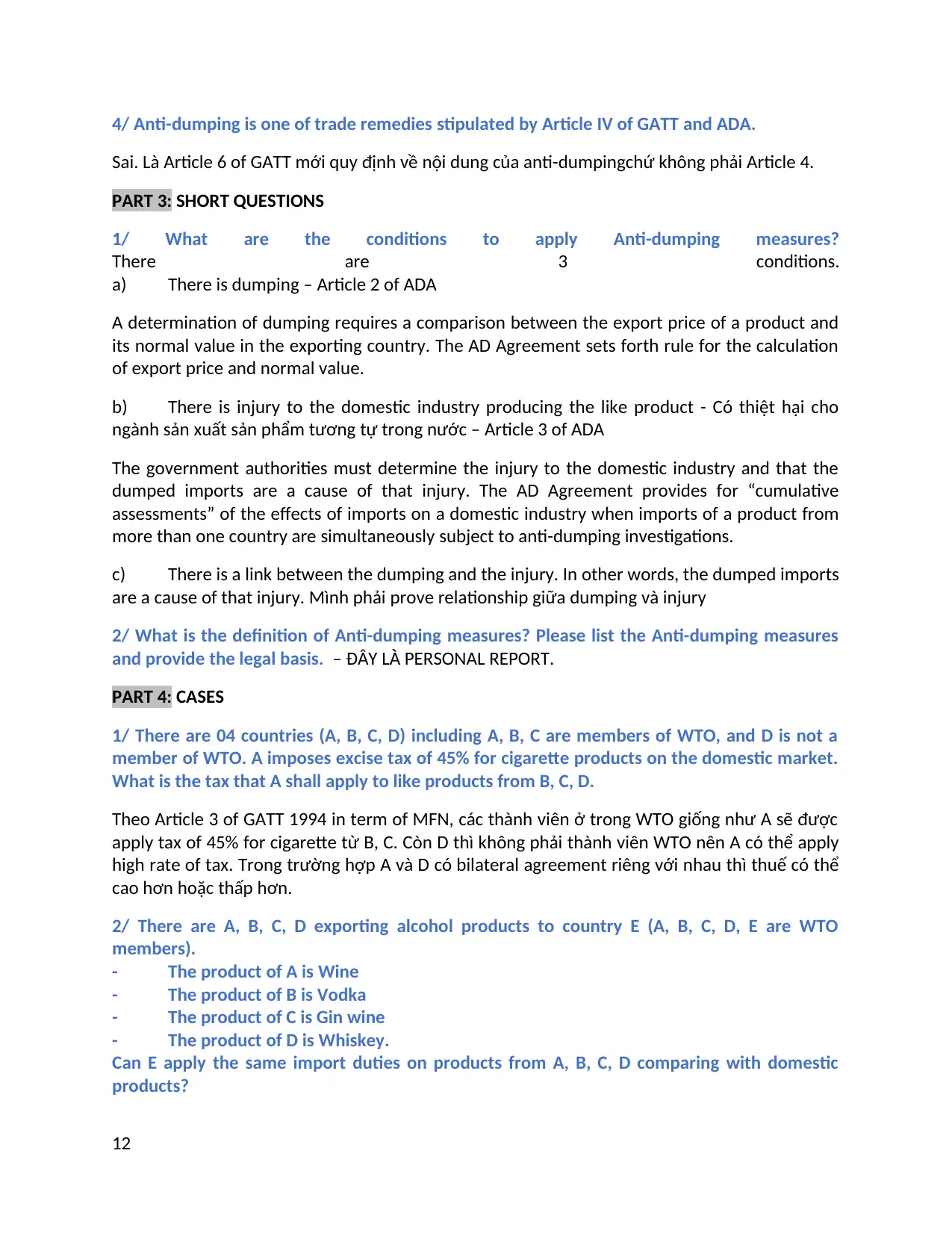
4/ Anti-dumping is one of trade remedies stipulated by Article IV of GATT and ADA.
Sai. Là Article 6 of GATT mới quy định về nội dung của anti-dumpingchứ không phải Article 4.
PART 3: SHORT QUESTIONS
1/ What are the conditions to apply Anti-dumping measures?
There are 3 conditions.
a) There is dumping – Article 2 of ADA
A determination of dumping requires a comparison between the export price of a product and
its normal value in the exporting country. The AD Agreement sets forth rule for the calculation
of export price and normal value.
b) There is injury to the domestic industry producing the like product - Có thiệt hại cho
ngành sản xuất sản phẩm tương tự trong nước – Article 3 of ADA
The government authorities must determine the injury to the domestic industry and that the
dumped imports are a cause of that injury. The AD Agreement provides for “cumulative
assessments” of the effects of imports on a domestic industry when imports of a product from
more than one country are simultaneously subject to anti-dumping investigations.
c) There is a link between the dumping and the injury. In other words, the dumped imports
are a cause of that injury. Mình phải prove relationship giữa dumping và injury
2/ What is the definition of Anti-dumping measures? Please list the Anti-dumping measures
and provide the legal basis. – ĐÂY LÀ PERSONAL REPORT.
PART 4: CASES
1/ There are 04 countries (A, B, C, D) including A, B, C are members of WTO, and D is not a
member of WTO. A imposes excise tax of 45% for cigarette products on the domestic market.
What is the tax that A shall apply to like products from B, C, D.
Theo Article 3 of GATT 1994 in term of MFN, các thành viên ở trong WTO giống như A sẽ được
apply tax of 45% for cigarette từ B, C. Còn D thì không phải thành viên WTO nên A có thể apply
high rate of tax. Trong trường hợp A và D có bilateral agreement riêng với nhau thì thuế có thể
cao hơn hoặc thấp hơn.
2/ There are A, B, C, D exporting alcohol products to country E (A, B, C, D, E are WTO
members).
- The product of A is Wine
- The product of B is Vodka
- The product of C is Gin wine
- The product of D is Whiskey.
Can E apply the same import duties on products from A, B, C, D comparing with domestic
products?
12
Sai. Là Article 6 of GATT mới quy định về nội dung của anti-dumpingchứ không phải Article 4.
PART 3: SHORT QUESTIONS
1/ What are the conditions to apply Anti-dumping measures?
There are 3 conditions.
a) There is dumping – Article 2 of ADA
A determination of dumping requires a comparison between the export price of a product and
its normal value in the exporting country. The AD Agreement sets forth rule for the calculation
of export price and normal value.
b) There is injury to the domestic industry producing the like product - Có thiệt hại cho
ngành sản xuất sản phẩm tương tự trong nước – Article 3 of ADA
The government authorities must determine the injury to the domestic industry and that the
dumped imports are a cause of that injury. The AD Agreement provides for “cumulative
assessments” of the effects of imports on a domestic industry when imports of a product from
more than one country are simultaneously subject to anti-dumping investigations.
c) There is a link between the dumping and the injury. In other words, the dumped imports
are a cause of that injury. Mình phải prove relationship giữa dumping và injury
2/ What is the definition of Anti-dumping measures? Please list the Anti-dumping measures
and provide the legal basis. – ĐÂY LÀ PERSONAL REPORT.
PART 4: CASES
1/ There are 04 countries (A, B, C, D) including A, B, C are members of WTO, and D is not a
member of WTO. A imposes excise tax of 45% for cigarette products on the domestic market.
What is the tax that A shall apply to like products from B, C, D.
Theo Article 3 of GATT 1994 in term of MFN, các thành viên ở trong WTO giống như A sẽ được
apply tax of 45% for cigarette từ B, C. Còn D thì không phải thành viên WTO nên A có thể apply
high rate of tax. Trong trường hợp A và D có bilateral agreement riêng với nhau thì thuế có thể
cao hơn hoặc thấp hơn.
2/ There are A, B, C, D exporting alcohol products to country E (A, B, C, D, E are WTO
members).
- The product of A is Wine
- The product of B is Vodka
- The product of C is Gin wine
- The product of D is Whiskey.
Can E apply the same import duties on products from A, B, C, D comparing with domestic
products?
12
⊘ This is a preview!⊘
Do you want full access?
Subscribe today to unlock all pages.

Trusted by 1+ million students worldwide
1 out of 28
Related Documents
Your All-in-One AI-Powered Toolkit for Academic Success.
+13062052269
info@desklib.com
Available 24*7 on WhatsApp / Email
![[object Object]](/_next/static/media/star-bottom.7253800d.svg)
Unlock your academic potential
Copyright © 2020–2025 A2Z Services. All Rights Reserved. Developed and managed by ZUCOL.





